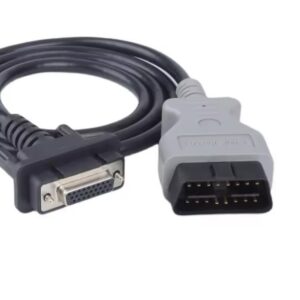Description
Ashok Leyland Scan Tool OBD-II Male to DB-15 Female cable :
obd2 scan tool Ashok Leyland Scantool Diagnostic Tool/ obd cable Features:
- Displays Vehicle Identification number.
- Read Stored fault Codes Reset / Erase fault codes.
- Live Readings of sensors.
- Freeze frame data readings.
- Start test / Control.
What is an obd2 scan tool used for?
Ashok Leyland Scantool /scanner cable provides vehicle data and trouble codes stored within the vehicle computer networks. Access to these codes and data directs the technician to the area of concern or where/what a malfunction could be.
Generic obd2 scan tool.
OBD-II is a government-mandated diagnostic protocol that is primarily aimed at diagnosing emissions-related problems. An OBD-II scan tool will work in many different brands of cars for engine emissions-based systems only.
Although you can use an OBD-II Scan Tool in an OBD-II compliant vehicle. An OBD-II Scan Tool can only query codes from the engine, not the numerous other “intelligent” systems in the car.
Diagnostic Ashok Leyland Scantool Vehicle Coverage.
Diagnostic Trouble Code (DTC) Definitions.
The Performance Tool OBD II Scan Tool is specially designed to work with all OBD II compliant vehicles. including those equipped with the next-generation protocol-Control Area Network (CAN).
Where to Connect?
Locate the 16-pin Data Link Connector (DLC) and plug it into the scan tool cable connector to the DLC. Location may vary depending on vehicle make and model but should be in the area between the steering wheel and peddles.
Caution: Don’t connect or disconnect any test equipment with the ignition on or engine running.
obd2 scan tool Display.
Wait for the LCD display to read:
‘C.A.N. OBD2’.
Once you see this screen, you are clear to move on to the next step and insert your key.
Check Engine Light.
The Check Engine Light must be on for the Diagnstic Scan Tool to send a trouble code. If there is not a check engine light on then there is nothing the vehicle’s computer can relay to the scan tool. If there is not a check engine light on, it does not guarantee that there is nothing wrong with the vehicle.
It is also an improvement over OBD-II in both capability and standardization. This Cable OBDII Connector standard specifies the type of diagnostic connector and its pinout, the electrical signaling protocols available, and the messaging format. It also provides a candidate list of vehicle parameters to monitor along with how to encode the data for each. There is also a pin in the connector that provides power for the scan tool from the vehicle battery, which eliminates the need to connect a scan tool to a power source separately.
In obd2 scan tool Cable Information of OBD2 Connector :
It also has a Female OBD-II connector on a car Female OBD Connector connector pinout – front view The OBDII specification provides for a standardized hardware interface—the female 16-pin (2×8) J1962 connector. Unlike the OBD-I connector, which was sometimes found, under the hood of the vehicle, the OBD-II connector is required to be within 2 feet (0.61 m) of the steering wheel.
SAE J1962 defines the pinout of the obd2 scan tool 16 pin connector as:
The amount of diagnostic information available via Scan Tool OBD2 Male OBDII has varied widely since its introduction in the early 1980s versions of onboard vehicle computers.
That is your car telling you there is an issue. If you visit a mechanic, he will use an OBD2 scanner to diagnose the issue.
To do so, he will connect the OBD reader to the OBD2 16 pin connector near the steering wheel.
This lets him read OBD codes aka Diagnostic Trouble Codes (DTCs) to review and troubleshoot the issue.
Features:
- It is also a Brand new and high-quality OBD-II to DB15 Female Car Diagnostic cable.
- For connecting your diagnostic interface and your vehicle with OBD-II compliant.
- Length: About 200cm.
- Weight: 300gm.
- OBD-II Plug: 16-pin male to car.
- Mostly Used for diagnostic Scan Tool OBD2 Male to DB15 Female Diagnostic Cable Engine Company Vehicles.
- Cable core: 8 Core
In Obd diagnostic Cable OBD Connector Pinout Configuration
| Pin Number | Pin Name | Description |
| 1,3,8,9,11,12,13 | Blank | These pins are not standard and are vendor-specific. It is also not required for normal communication/interfacing. |
| 2 | SAE J1850 Bus+ | Likewise, This protocol uses Variable Pulse Width and is normally used by GM vehicles. This is the Bus positive pin of the protocol. |
| 10 | SAE J1850 Bus- | This protocol uses Variable Pulse Width and is normally used by GM vehicles. This is the Bus negative pin of the protocol. |
| 4,5 | Ground | Likewise, The ground of complete system of the Car including chassis. |
| 6 | ISO15765-4 CAN High | It follows a 2-wire CAN protocol at 1Mbps speed. It also CAN high Pin. |
| 14 | ISO15765-4 CAN Low | It follows a 2-wire CAN protocol at 1Mbps speed. It also CAN low Pin. |
| 7 | ISO 9141 – K Line | It follows an asynchronous serial communication protocol. It also Kline Pin. |
| 8 | ISO 9141 – L Line | It also follows the same as pin no 7, this pin is the L line. |
Information
Brand New & High-Quality Ashok Leyland Scan Tool OBD-II Male to DB-15 Female cable.
For Connecting your Diagnostic Interface and your Ashok Leyland vehicle with OBD-II Compliant.
Length is about 150 cm.
OBD-II Plug: 16 Pin Male to the car.
Easy to Use.
Tag: Ashok Leyland Scantool Cable OBD2 Scan Tool Cable Diagnostic Tool BS6 Scantool Cable
















